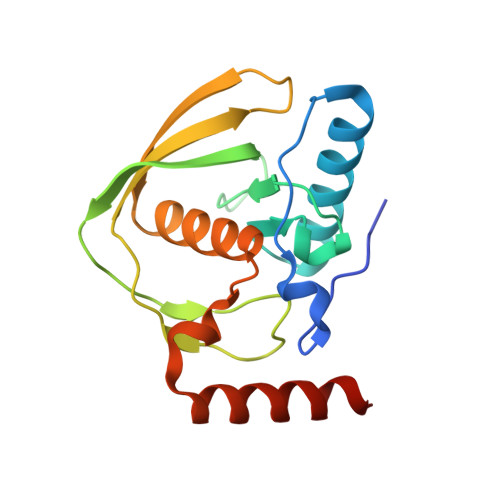Structural Insights into Antibacterial Payload Release from Gold Nanoparticles Bound to E. coli Peptide Deformylase.
Kirschner, H., John, M., Zhou, T., Bachmann, N., Schultz, A., Hofmann, E., Bandow, J.E., Scherkenbeck, J., Metzler-Nolte, N., Stoll, R.(2024) ChemMedChem 19: e202300538-e202300538
- PubMed: 38057137
- DOI: https://doi.org/10.1002/cmdc.202300538
- Primary Citation of Related Structures:
8OFE - PubMed Abstract:
The lack of new antibiotics and the rapidly rising number of pathogens resistant to antibiotics pose a serious problem to mankind. In bacteria, the cell membrane provides the first line of defence to antibiotics by preventing them from reaching their molecular target. To overcome this entrance barrier, it has been suggested [1] that small Gold-Nanoparticles (AuNP) could possibly function as drug delivery systems for antibiotic ligands. Using actinonin-based ligands, we provide here proof-of-principle of AuNP functionalisation, the capability to bind and inhibit the target protein of the ligand, and the possibility to selectively release the antimicrobial payload. To this end, we successfully synthesised AuNP coated with thio-functionalised actinonin and a derivative. Interactions between 15 N-enriched His-peptide deformylase 1-147 from E. coli (His-ecPDF 1-147) and compound-coated AuNP were investigated via 2D 1 H- 15 N-HSQC NMR spectra proving the direct binding to His-ecPDF 1-147. More importantly by adding dithiothreitol (DTT), we show that the derivative is successfully released from AuNPs while still bound to His-ecPDF 1-147. Our findings indicate that AuNP-conjugated ligands can address and bind intracellular target proteins. The system introduced here presents a new delivery platform for antibiotics and allows for the easy optimisation of ligand coated AuNPs.
- Biochemistry II, Biomolecular NMR Spectroscopy, RUBiospec|NMR and PhenomeCentre@RUBUAR, Faculty of Chemistry and Biochemistry, Ruhr University Bochum, Universitätsstraße 150, 44801, Bochum, Germany.
Organizational Affiliation:


















